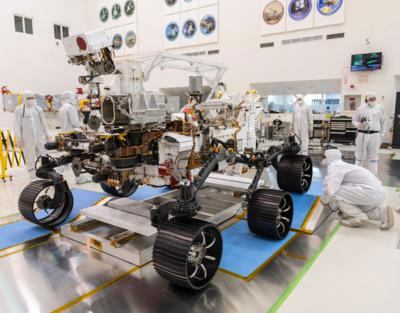The Merits of Perseverance
NASA’s Perseverance rover is a car-sized, six-wheeled rover designed to explore the Jezero Crater in Mars’s Syrtis Major quadrangle. The crater measures approximately 28-miles in diameter and is thought to have once been flooded with liquid water in which life may have existed. In some Slavic languages, the term "jezero" mans lake.

Since arriving on Mars in February 2020, Perseverance has been about the business of investigating Martian astrobiology by caching rock and soil samples that may contain signs of ancient microbial life. Since 07 July 2022, the vehicle has collected four samples from an ancient river delta in the Jezero Crater, thereby bringing the total number of scientifically compelling rock specimens to 12.
NASA associate administrator for science Thomas Zurbuchen states: “We picked the Jezero Crater for Perseverance to explore because we thought it had the best chance of providing scientifically excellent samples—and now we know we sent the rover to the right location.”
Geologists posit the delta Perseverance is investigating formed approximately 3.5-billion years ago at the convergence of a Martian river and a lake.
Perseverance project scientist Dr. Ken Farley of Caltech remarks: “The delta, with its diverse sedimentary rocks, contrasts beautifully with the igneous rocks—formed from crystallization of magma—discovered on the crater floor. This juxtaposition provides us with a rich understanding of the geologic history after the crater formed and a diverse sample suite. For example, we found a sandstone that carries grains and rock fragments created far from Jezero Crater – and a mudstone that includes intriguing organic compounds.”
On 20 July 2022—the 509th Marian day of its mission—Perseverance investigated Wildcat Ridge—a rock outcropping about three-feet (one-meter) wide that likely formed billions of years ago as mud and fine sand settled in an evaporating saltwater lake. The rover extracted cylindrical samples from the geological formation for purpose of analyzing the substrate with an instrument NASA very contrivedly calls Scanning Habitable Environments with Raman & Luminescence for Organics & Chemicals, or SHERLOC.
Within the Wildcat Ridge samples, SHERLOC detected a class of organic molecules spatially correlated with those of sulfate minerals. Within sedimentary rock, such minerals often yield information germane to the aqueous environments in which they formed. The organic molecules present within the Wildcat Ridge samples were the most abundant yet discovered on Mars.

Organic molecules consist of a wide variety of compounds comprising primarily carbon, hydrogen, and oxygen atoms; though nitrogen, phosphorus, and sulfur are also commonly observed. The presence of such molecules speaks to—albeit not definitively—the presence or one-time presence of life.
Dr. Farley adds: “In the distant past, the sand, mud, and salts that now make up the Wildcat Ridge sample were deposited under conditions where life could potentially have thrived. The fact that organic matter was found in such a sedimentary rock—known for preserving fossils of ancient life here on Earth—is important. However, as capable as our instruments aboard Perseverance are, further conclusions regarding what is contained in the Wildcat Ridge sample will have to wait until it’s returned to Earth for in-depth study as part of the agency’s Mars Sample Return campaign.”
To date, Perseverance has collected numerous samples of Martian rock, soil, and atmosphere—the entirety of which are stored within the contraption’s hull. The rover will presently offload the samples at a collections site near the base of the Jezero Crater delta before continuing its explorations. Near-future NASA missions—undertaken jointly with the European Space Agency (ESA)—will collect the Perseverance samples from the Martian surface and return them to Earth for in-depth analysis.
Laurie Leshin, director of NASA's Jet Propulsion Laboratory in Southern California, asserts: “I’ve studied Martian habitability and geology for much of my career and know first-hand the incredible scientific value of returning a carefully collected set of Mars rocks to Earth. That we are weeks from deploying Perseverance’s fascinating samples and mere years from bringing them to Earth so scientists can study them in exquisite detail is truly phenomenal. We will learn so much.”
 NTSB Final Report: Rutan Long-EZ
NTSB Final Report: Rutan Long-EZ ANN FAQ: Turn On Post Notifications
ANN FAQ: Turn On Post Notifications Classic Aero-TV: ICAS Perspectives - Advice for New Air Show Performers
Classic Aero-TV: ICAS Perspectives - Advice for New Air Show Performers ANN's Daily Aero-Linx (06.28.25)
ANN's Daily Aero-Linx (06.28.25) Aero-News: Quote of the Day (06.28.25)
Aero-News: Quote of the Day (06.28.25)




